On This Page
Birds of a Feather Work Together
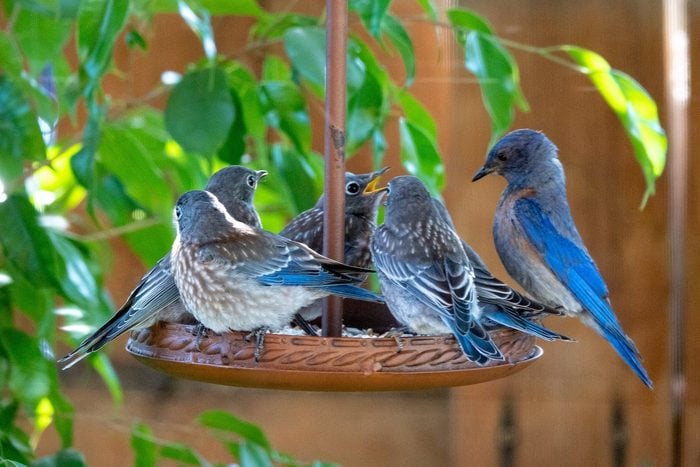
Avid bird-watchers probably notice that some birds are solitary, like the lone hawk perching along the highway. And some are social, like the goldfinches and cedar waxwings that flock to our gardens. We could say that their degree of social bird behavior is part of the personality of each species. But when birds gather, it isn’t just because they enjoy each other’s company. There are practical reasons that explain why some birds flock together and even work together.
Group Nest Building Bird Behavior
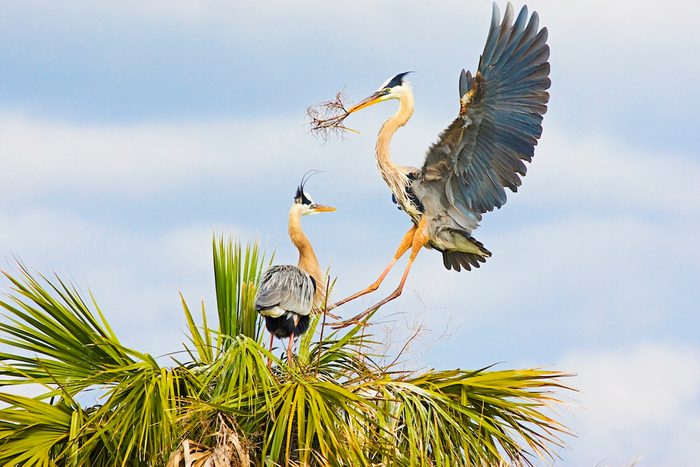
For a pair of birds to successfully raise young, building a nest is an important step. Unfortunately for many species, there’s no attempt at teamwork: Female robins, cardinals and hummingbirds all build nests with no help from their mates. Even the intricate woven nests of orioles are all the mothers’ doing.
But the news about the guys isn’t all bad. Some males—including red-eyed vireos, mourning doves, red-tailed hawks, bald eagles and great blue herons—bring building supplies like twigs, grasses and plant fibers for the female to shape into a nest. Among some wrens, the male builds the main structure and the female adds the nest lining.
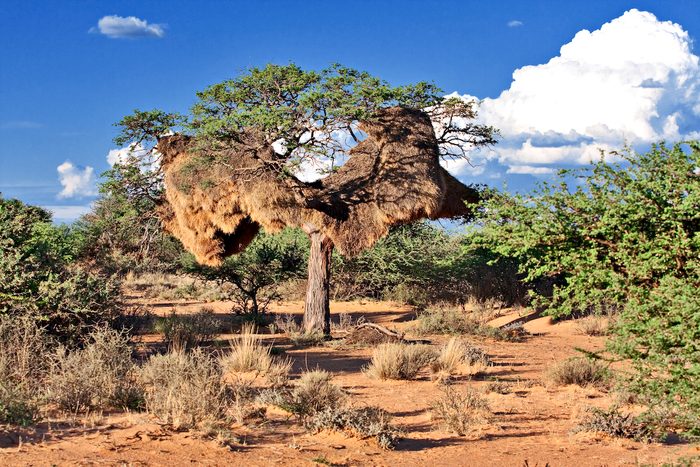
For one African bird, the sociable weaver, nest building is a task for an entire flock. A sociable weaver nest may look like a gigantic haystack draped over a short, sturdy tree. But up close, you can see dozens of small entrances on the underside, leading to individual nesting chambers. Sometimes more than a hundred pairs may help to build a single group nest—an almost unbelievable example of cooperative bird behavior.
Cooperating to Find Food
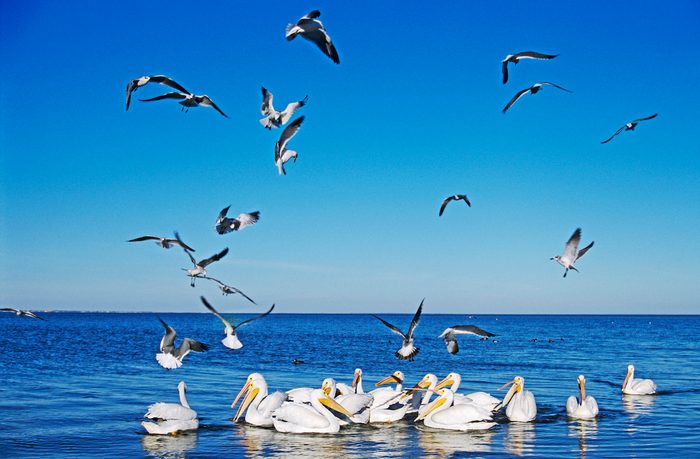
Even a flocking bird, when it comes time to eat, must look out for number one. But in some cases, birds will work together to find or catch their food. In the deserts of the Southwest, a family group of Harris’s hawks may hunt together. One or two swoop in to scare a rabbit out of a bush, while another waits to grab it as it dashes away. If their hunt is successful, the hawks will share the meal, with the dominant bird eating first and the others getting the leftovers.
Another fascinating example is the cooperative fishing of American white pelicans. These huge birds will line up side by side on the water and swim together toward the shore, dipping their bills in the water and driving fish ahead of them into the shallows, where they can be scooped up easily.
Winter Survival: Follow the Leader
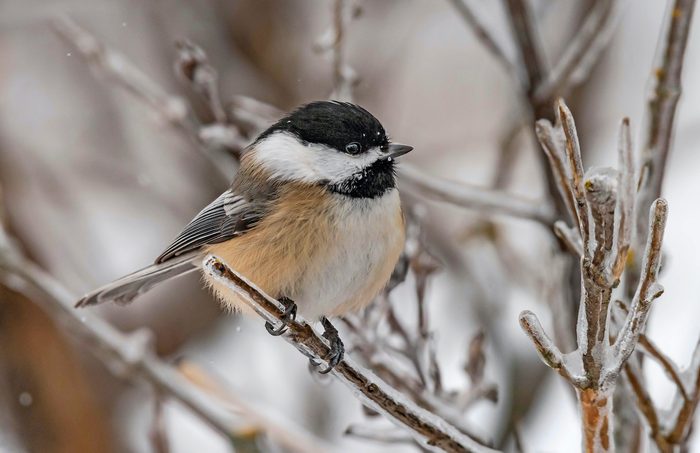
Here’s a wintertime wonder you might see in any neighborhood with plenty of trees: a roving mixed flock of five or six kinds of birds making its way through the woods together. The leaders of the pack will be a flock of chickadees, flitting like acrobats in the outer twigs. Often there will be one or two nuthatches, a downy woodpecker and perhaps a brown creeper following along, clambering up tree trunks. A few titmice, a kinglet or two and sometimes a yellow-rumped warbler may join the flock.
These mixed flocks form because other birds like to follow chickadees around. Chickadees are active, alert birds, always on the lookout in every direction. They are quick to spot any hawk or other predator that comes near.
Birds like nuthatches or creepers, moving along with their faces next to tree bark, may be less likely to notice the approach of danger. But they can simply listen to the chickadees and fly to safety when the usual chatter of the little birds turns to alarm calls.
Learn about another fascinating bird behavior: caching food.
Bird Mobbing Behavior
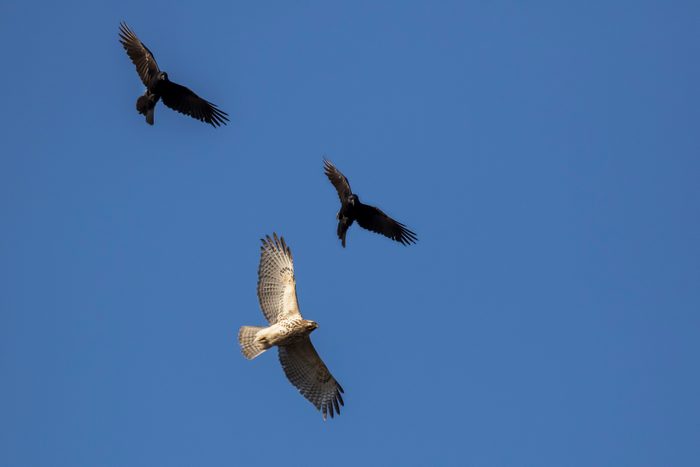
The concept of safety in numbers gets cranked up another notch when birds engage in mobbing behavior. If songbirds discover an owl roosting in the daytime, they gather around and badger it with alarm calls, sometimes flying at it and even pecking at the back of its head.
Small predators like screech-owls are usually mobbed by small songbirds. Big ones like great horned owls are more likely to be mobbed by crows or other larger birds. The owls are seldom driven away by this harassment, so it might seem that the mobbing behavior doesn’t work. But it does mean that all the birds in the neighborhood know the owl’s location, so they won’t be taken by surprise.
Bird mating behavior: who’s the boss?
Sharing Child Care Duties as a Flock
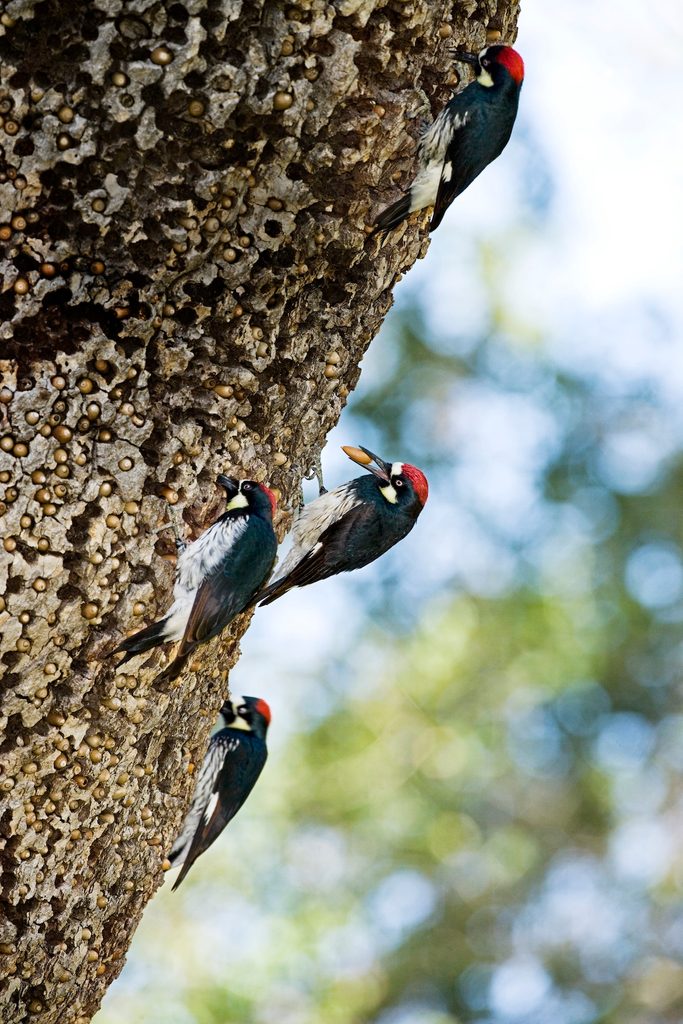
If you ever watch a nesting pair of American crows, you might get the impression that more than just two adults are bringing food to the young birds in the nest. And you’d be right. Pairs of crows very often have assistants, usually their own offspring from previous years, bringing food and helping to guard the nest. Some crow nests have five or more helpers in addition to the parents. The same kinds of helpers have been observed in many other species, from purple gallinules to western bluebirds.
Some birds take group nesting behavior to an even higher level. Among the groove-billed ani, an odd tropical cuckoo that gets as far north as Texas, up to four pairs of adults cooperate to build one big nest, where all the females lay their eggs. All the adults in the group help with incubating the eggs and feeding the young.
The ultimate example of cooperative bird behavior may be the acorn woodpecker. In western oak woods, these gaudy birds live in colonies of a dozen or more. One, two or three females may lay eggs in a single nest; after the eggs hatch, all the adults in the group feed the young birds. But the woodpeckers don’t cooperate just at nesting. They also work as a group every fall to harvest acorns and store them in dead trees riddled with holes, saving up enough food to help the flock live through the winter.
Watch Birds to Observe Their Behavior
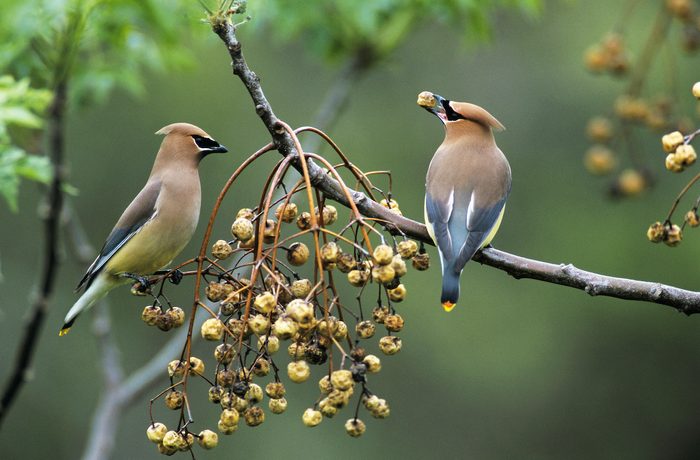
These are just a few examples of the ways birds can work together. If you watch carefully, you may discover something new about the birds right outside your window. Even the most common of them can still surprise us with their bird behavior.
Why Trust Us
For nearly 30 years, Birds & Blooms, a Trusted Media Brand, has been inspiring readers to have a lifelong love of birding, gardening and nature. We are the #1 bird and garden magazine in North America and a trusted online resource for over 15 million outdoor enthusiasts annually. Our library of thousands of informative articles and how-tos has been written by trusted journalists and fact-checked by bird and garden experts for accuracy. In addition to our staff of experienced gardeners and bird-watchers, we hire individuals who have years of education and hands-on experience with birding, bird feeding, gardening, butterflies, bugs and more. Learn more about Birds & Blooms, our field editor program, and our submission guidelines.
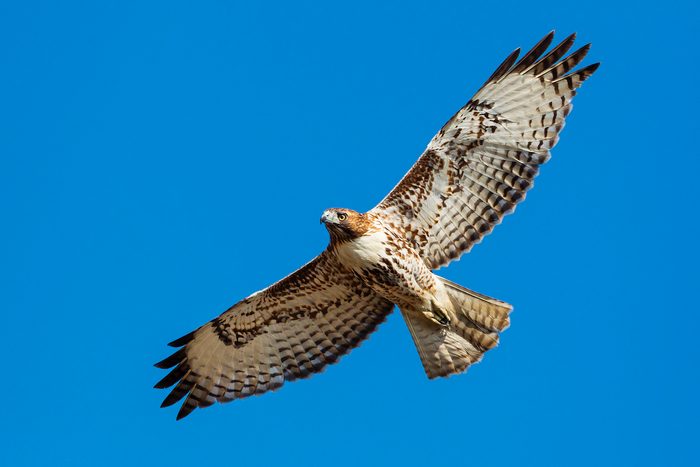
Do hawks migate? The answer is yes, and often in large groups. In certain places where land meets water or where mountain ridges create geographic funnels, migrating raptors gather in huge numbers every autumn. Many birds of prey look for thermals, which are rising columns of air that form when the sun heats the earth, to help them soar as high as 3,000 feet. “Riding the thermals helps raptors conserve energy as they head south for the winter,” says Step Wilson, Hawkwatch program manager at the Golden Gate Raptor Observatory in San Francisco.
Bird-watchers and scientists observe hawk migration in the U.S. from late August to mid-December, with species numbers and types changing as the season progresses. At hot spots across the country, researchers safely capture and band hawks, and volunteers perform daylong counts as the birds fly over. Here are a few places to witness high-flying migrants.
For more birding tips, sign up for our free daily newsletter.
On This Page
Hawk Migration Watching Tips
Follow these tips when you set off to watch hawks migrate.
- When to Go: A sunny day with some clouds and northwest winds about 15-20 mph is best for raptor watching. Hawks typically fly from about 10 a.m. to late afternoon.
- What to Bring: Pack layers of clothing, water, binoculars and snacks. Don’t forget to wear sturdy hiking boots.
- What to Expect: Be prepared for an uphill climb at some observatories. Hawk-watching requires a little patience, but expect the unexpected.
Check out essential hawk identification tips for birders.
Hawk Mountain Sanctuary, Pennsylvania
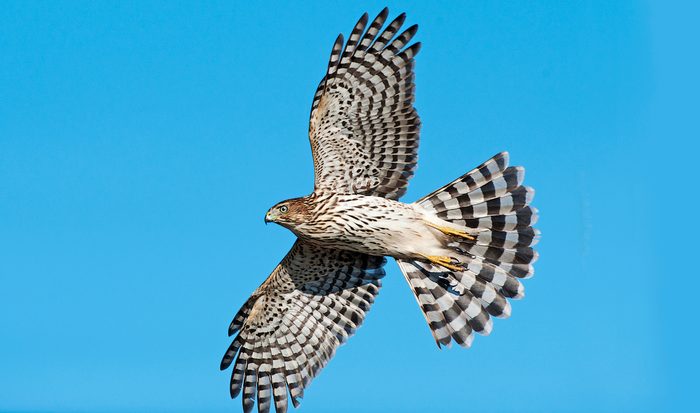
An annual hawk watch occurs daily at Hawk Mountain Sanctuary, a 2,600-acre scenic preserve, from Aug. 15 to Dec. 15. Check out North Lookout, only a mile from the visitor center, where an average of 18,000 hawks, eagles and falcons are counted each season.
Highlights include large numbers of broad-winged hawks in September. Plus, spotters have seen more than 1,000 sharp-shinned hawks in a single day in October and more than 1,000 red-tailed hawks a day in late October and early November.
Hawk Mountain was the first refuge for birds of prey in the world. It was protected in 1934 in order to stop the hunting of birds of prey for sport and opened to the public the following year so that people could observe these amazing birds. This site is now one of the most popular hawk watch location in the eastern U.S.
Smith Point Hawk Watch, Texas
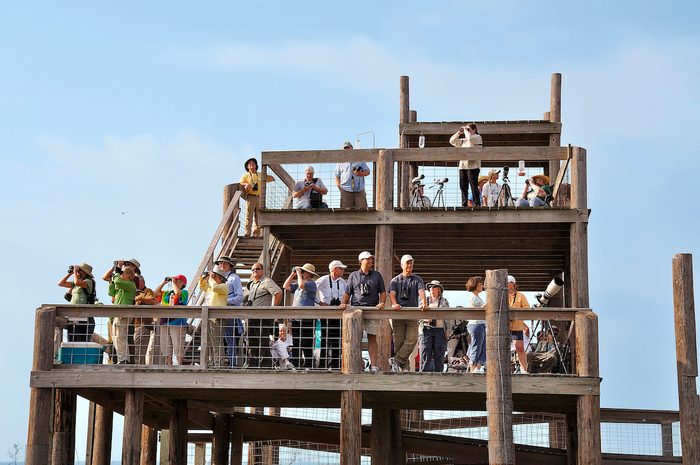
At some hawk watches, raptors are too high for beginners to identify, but at Smith Point Hawk Watch, visitors take spectacular photos and get close looks as birds fly over a tower set up for counting.
Raptors congregate when they reach Galveston Bay and must decide whether to cross it or choose another route. Some 50,000 to 100,000 individuals, such as broad-winged hawks, Mississippi kites and sharp-shinned hawks, pass through each season, along with black and turkey vultures.
About an hour from Smith Point, the Gulf Coast Bird Observatory and HawkWatch International conduct a watch at the Candy Abshier Wildlife Management Area in Port Arthur, Texas, where up to 19 hawk species show up at different times during the season.
Check out birding hotspots for spring sandhill crane migration.
Corpus Christi HawkWatch, Texas
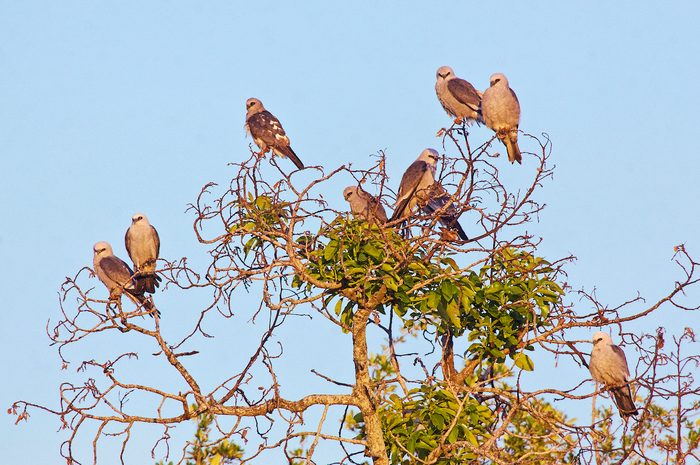
More than 1 million migratory raptors were counted in a single season along the Nueces River by Corpus Christi HawkWatch. Researchers and visitors see broad-winged hawks and sharp-shinned hawks as well as Mississippi kites, turkey vultures and some rare finds, including zone-tailed hawks and swallow-tailed kites. It’s one of the best places in the U.S. to view the largest concentration of migrating raptors each fall.
Visit early August through November and join researchers at the covered platform on a bluff at Hazel Bazemore County Park.
Hawk Ridge Bird Observatory, Minnesota
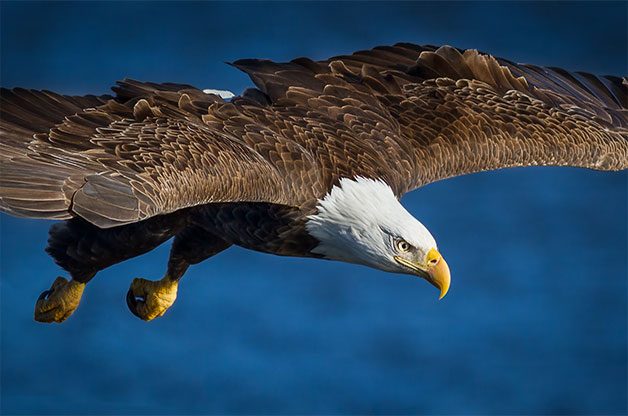
Hawk Ridge attracts visitors from more than 40 countries to witness raptor migration. Owned by the city of Duluth and managed by the Hawk Ridge Bird Observatory, the site features a main overlook on Skyline Parkway at the western tip of Lake Superior.
Most raptors avoid large bodies of water, so when they reach Lake Superior, they congregate along the lakeshore and outlying bluffs. As the birds of prey come around the lake, they fly right past Hawk Ridge, making this an ideal location for a hawk watch. Like many of the hawk migration watches in the eastern US, this site gets an incredible number of broad-winged hawks! Researchers count an average of 76,000 birds of prey each season and band about 3,000 of them annually.
Twenty species, including owls, are spotted here during autumn. Sharp-shinned hawks and broad-winged hawks come through in September. Red-tailed hawks, rough-legged hawks and bald eagles, sometimes hundreds in one day, are present into December. Visitors might see barred, long-eared and other owls in small numbers. The best time to visit is Sept. 1 to Oct. 31. Naturalists are also on hand to answer questions and present live bird demonstrations.
Cape May Bird Observatory, New Jersey
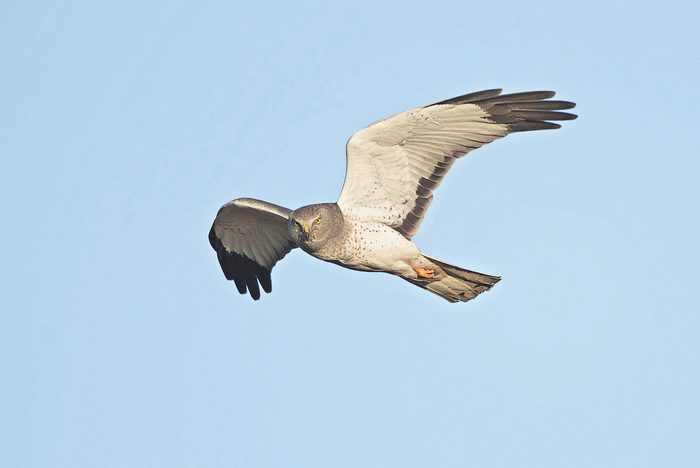
Cape May, a peninsula bordered by Delaware Bay and the Atlantic Ocean, serves as a natural funnel for migrating raptors. An average of 17 species are counted here from September through November. After a cold front passes, spotters may see large flights of sharp-shinned hawks, sometimes numbering in the hundreds to thousands. Other stars here include red-tailed hawks, peregrine falcons, osprey and northern harriers.
Scientists have counted birds here for 40 years. Researchers and visitors congregate at the hawk migration watch platform near the parking lot at Cape May Point State Park from Sept. 1 to Nov. 30 to observe the spectacle. A festival sponsored by New Jersey Audubon takes place in late October.
Golden Gate Raptor Observatory, California
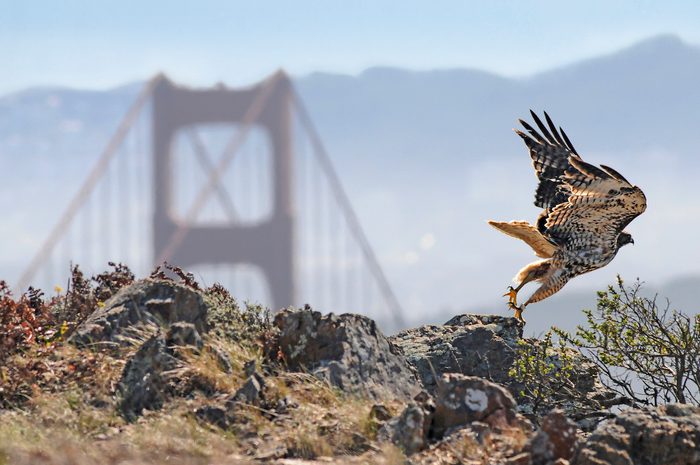
Researchers have been spotting hawk migration at various vantage points here from mid-August until mid-December for 33 years. Some birds come quite close, and 800 or more sharp-shinned hawks might fly by in one day. Specialties include large numbers of turkey vultures and different morphs of red-tailed hawks, all the way from typical pale birds to dark morph individuals that look almost black.
The best and most accessible place for viewing is Hawk Hill, along Conzelman Road in the Golden Gate National Recreation Area. From September through November, visitors can view up to 19 species of raptors while enjoying views of the Pacific Ocean, Golden Gate Bridge and the Marin Headlands.
Discover the top warbler hotspots to visit in spring.
Florida Keys Hawkwatch
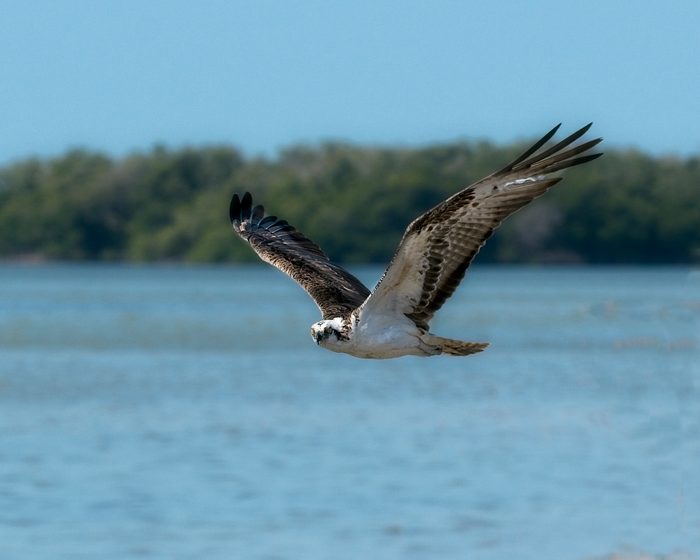
This hawk migration hotspot is a little different than the others in this list. Most birds of prey avoid going over large bodies of water, but a few species such as peregrine falcon and osprey don’t seem to mind. In 2012, this location set the world record for the total number of peregrine falcons (3,836) during a single migration season.
Learn more on the hawk watch’s official blog.
Detroit River, Michigan
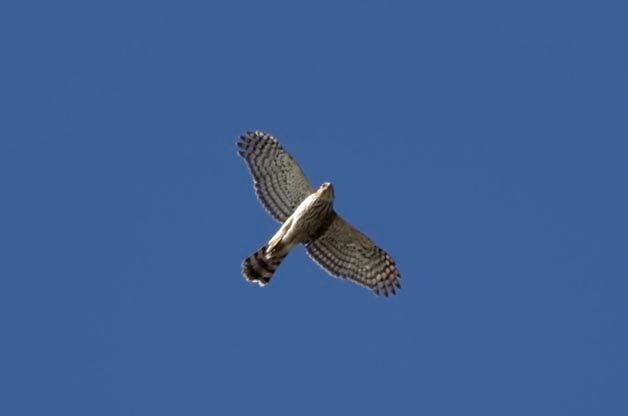
The Detroit River Hawk Watch is located on the west end of Lake Erie and thousands of broad-winged hawks migrate over this spot. Be sure to visit during the middle of September to have the best chance to see a huge movement of birds of prey.
Check out more Great Lakes birding hotspots.
About the Expert
Step Wilson is the Hawkwatch program manager at the Golden Gate Raptor Observatory in San Francisco, California. He has been studying and working with raptor since he started as a volunteer bander in 1995.
Sources
- Hawk Mountain Sanctuary
- Smith Point Hawk Watch
- Gulf Coast Bird Observatory
- HawkWatch International
- Candy Abshier Wildlife Management Area
- Corpus Christi Hawkwatch
- Hazel Bazemore County Park
- Hawk Ridge Bird Observatory
- Cape May Bird Observatory
- Cape May Point State Park
- New Jersey Audubon
- Golden Gate Raptor Observatory
- Golden Gate National Recreation Area
- Florida Keys Hawkwatch
- Detroit River Hawk Watch
Why Trust Us
For nearly 30 years, Birds & Blooms, a Trusted Media Brand, has been inspiring readers to have a lifelong love of birding, gardening and nature. We are the #1 bird and garden magazine in North America and a trusted online resource for over 15 million outdoor enthusiasts annually. Our library of thousands of informative articles and how-tos has been written by trusted journalists and fact-checked by bird and garden experts for accuracy. In addition to our staff of experienced gardeners and bird-watchers, we hire individuals who have years of education and hands-on experience with birding, bird feeding, gardening, butterflies, bugs and more. Learn more about Birds & Blooms, our field editor program, and our submission guidelines.
On This Page
Chestnut-Sided Warbler Identification
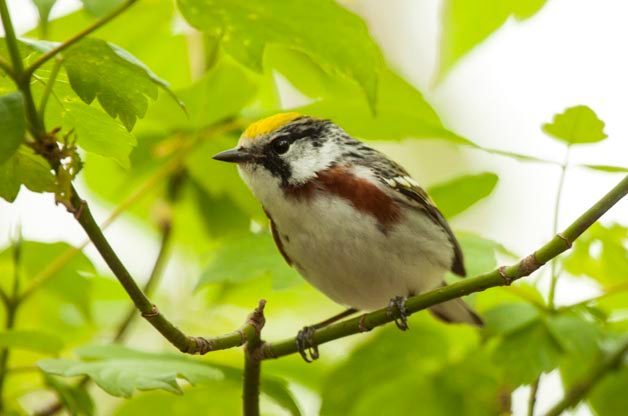
A tiny, fast-moving warbler is always a challenge for birders to identify. Look for chestnut streaks on the bird’s sides to know for sure whether you’ve spotted a chestnut-sided warbler. Males have a bright yellow cap and black streaks over the eyes; wings have yellow accents.
Females have similar plumage to males, although diluted. They can lack the male’s chestnut accents, and streaks over the eyes appear grayish rather than bold black.
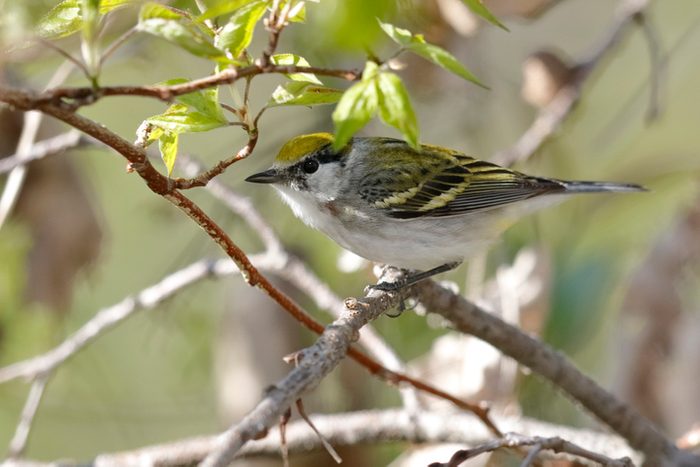
During nonbreeding season, males adopt a slightly different plumage. They lose their black eye streaks and gain a white ring around the eyes, and the chestnut sides take on a lighter, streaky quality.
For another clue to help identify these warblers, watch their tails.
“One of the fun things about them, which I learned in Costa Rica, is that of all warblers, they hold their tails up the most,” says Dr. Kevin J. McGowan, senior course developer for the Cornell Lab of Ornithology’s Bird Academy. “You’re so used to the yellow crown and the chestnut sides, and the female being that yellowish green, but if you think about it—yeah, they do. They keep their tail up more than other warblers do, for sure.”
Learn how to identify and attract a yellow-rumped warbler.
Range and Habitat
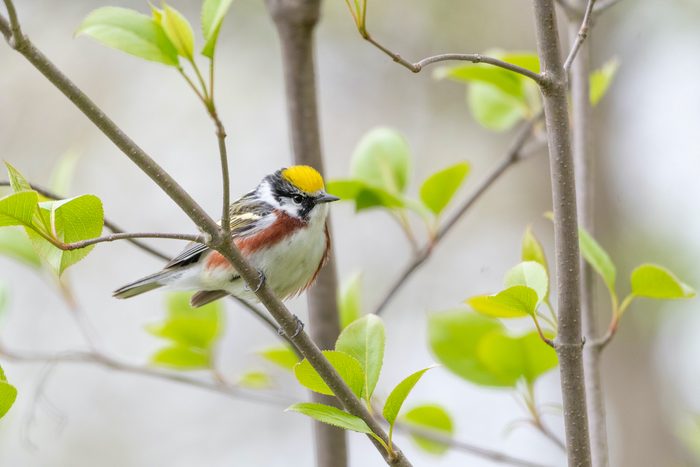
As is the case with many warblers, the chestnut-sided warbler flies through much of the eastern half of the United States during its spring and fall migration journeys. It spends the breeding season in the northern United States and Canada (with a section of its range extending through West Virginia).
Chestnut-sided warblers usually stay in new-growth forests recovering from damage of some kind (logging, fire, or storms). When a habitat becomes too “grown over,” they’ll move on to another regenerating habitat.
“They’re in second-growth, so not mature forests,” Kevin says. “When you get into a solid, closed-canopy forest, they drop out. They do tend to be in more open areas, which does make them easier to spot.”
Discover fascinating facts about warblers that will make you love them even more.
What Does a Chestnut-Sided Warbler Eat?
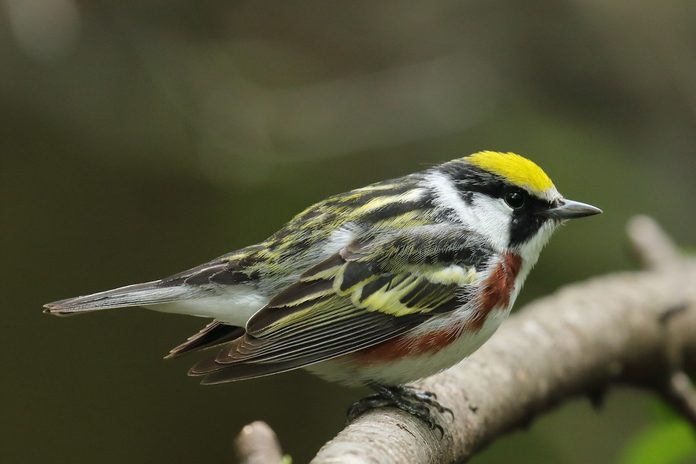
Chestnut-sided warblers eat a typical warbler diet: which is to say, they mostly eat bugs. They’ll dine on caterpillars and fly larvae, as well as moths, beetles, and other flying insects that they dart out to catch in midair. They’ll also find bugs on the undersides of leaves as they hop through shrubs and trees.
Because they don’t eat seed, it’s unlikely one would visit a feeder; however, it might stop by a bird bath.
These pictures of warblers will make you want to go birding.
Nest and Eggs
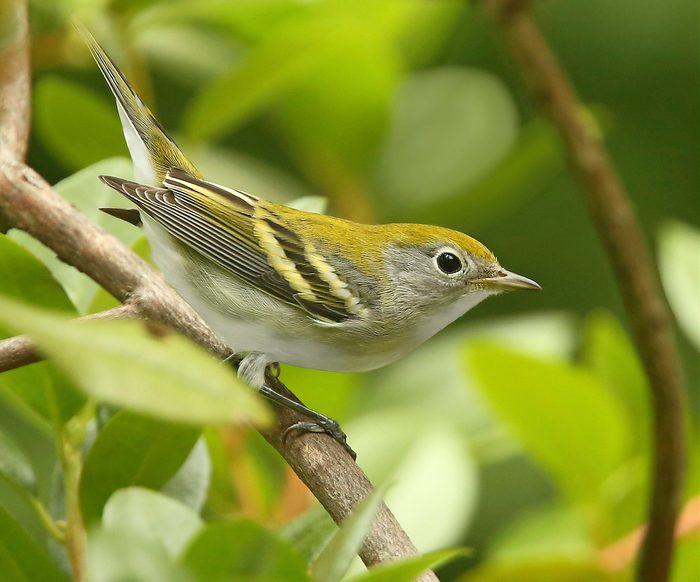
Females build a cup-style nest low to the ground, in shrubs or deciduous trees. They typically lay four eggs, although they can lay as few as three or as many as five, and they’ll have up to two broods per season.
The female incubates the eggs for about a week and a half, and after another week and a half after hatching, the young are ready to leave the nest.
Here’s how to attract prothonotary warblers to your birdhouses.
Chestnut-Sided Warbler Song
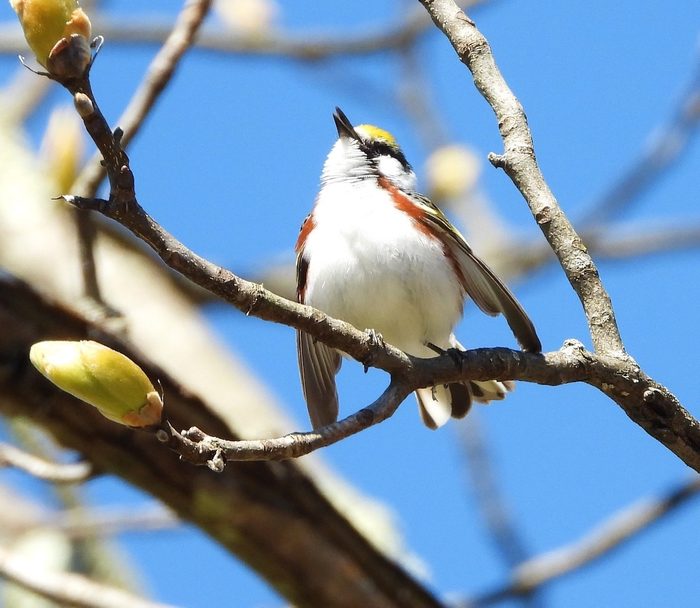
Some birders describe the lyrics of this eastern migrant’s song as pleased to meetcha.
Next, learn all about black-and-white warblers.
About the Expert
Lifelong birder and ornithologist Dr. Kevin McGowan is a senior course developer for the Cornell Lab of Ornithology’s Bird Academy. He earned a Ph.D in biology at the University of South Florida.
Sources
Why Trust Us
For nearly 30 years, Birds & Blooms, a Trusted Media Brand, has been inspiring readers to have a lifelong love of birding, gardening and nature. We are the #1 bird and garden magazine in North America and a trusted online resource for over 15 million outdoor enthusiasts annually. Our library of thousands of informative articles and how-tos has been written by trusted journalists and fact-checked by bird and garden experts for accuracy. In addition to our staff of experienced gardeners and bird-watchers, we hire individuals who have years of education and hands-on experience with birding, bird feeding, gardening, butterflies, bugs and more. Learn more about Birds & Blooms, our field editor program, and our submission guidelines.
On This Page
What Does a Wilson’s Warbler Look Like?
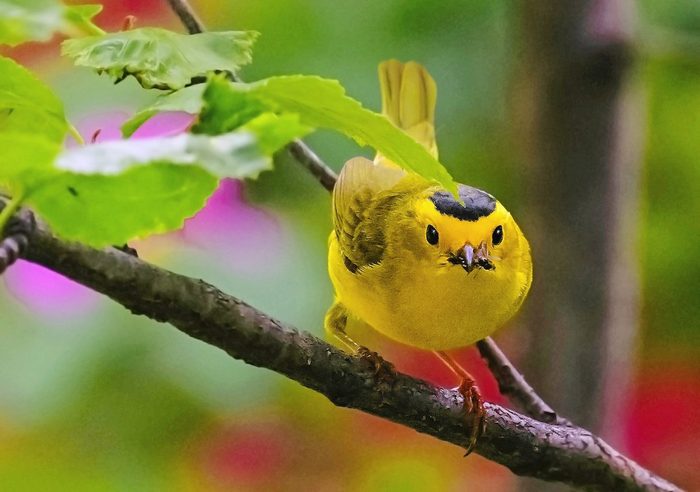
In a sea of small, fast-moving and tricky-to-identify warblers, the Wilson’s warbler is easy to remember. With its lemon-yellow body and a distinctive black cap, it sticks in the memory. Its cap, in fact, has led birders to remember it by saying, “Wilson wears a hat.”
That saying works for male Wilson’s warblers, but it doesn’t apply so well to females. Female Wilson’s warblers follow the same general color scheme as males, but they lack that bold black cap, instead replacing it with olive plumage. Worth noting is that some females do have some black feathers atop the head.
Interestingly, the Wilson’s warbler used to be known by a different name. Now that bird species named after people are being re-named, it’s possible it might return to the original name.
“Pileated warbler, it was called at one point,” says Dr. Kevin McGowan, senior course developer for the Cornell Lab of Ornithology’s Bird Academy. If that makes you think of a huge pileated woodpecker, it might seem an odd name choice for a tiny warbler…but consider the pattern of these birds’ plumage. “[The warbler was called ‘pileated’] because ‘pileated’ refers to the top of the head, and it has a cap,” Kevin says.
Discover more fascianting facts about warblers.
Wilson’s Warbler Range and Habitat
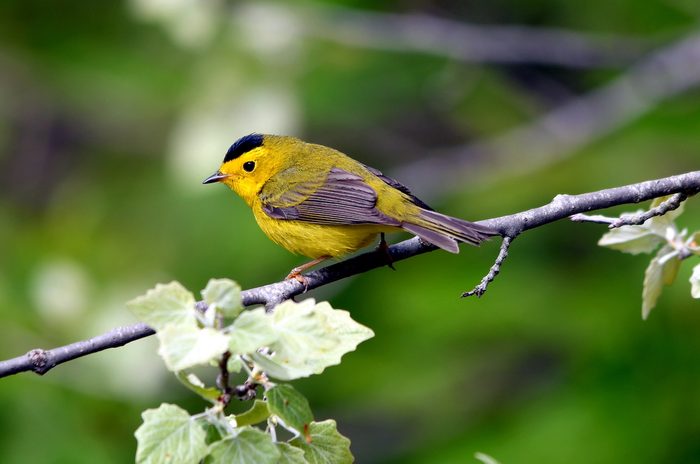
If you live anywhere within the United States, you have a good chance at spotting a Wilson’s warbler. They pass through the entirety of the country during fall and spring migration. They stick around along the California coast, the Pacific Northwest, and in Canada for all of breeding season.
“The Wilson’s warbler is interesting because it occurs all over the United States, but it’s a more common bird in the West,” says Kevin. “It’s relatively uncommon in the East, depending on where you are. They like wet shrub thickets, but they can be found just about anywhere, especially during migration.”
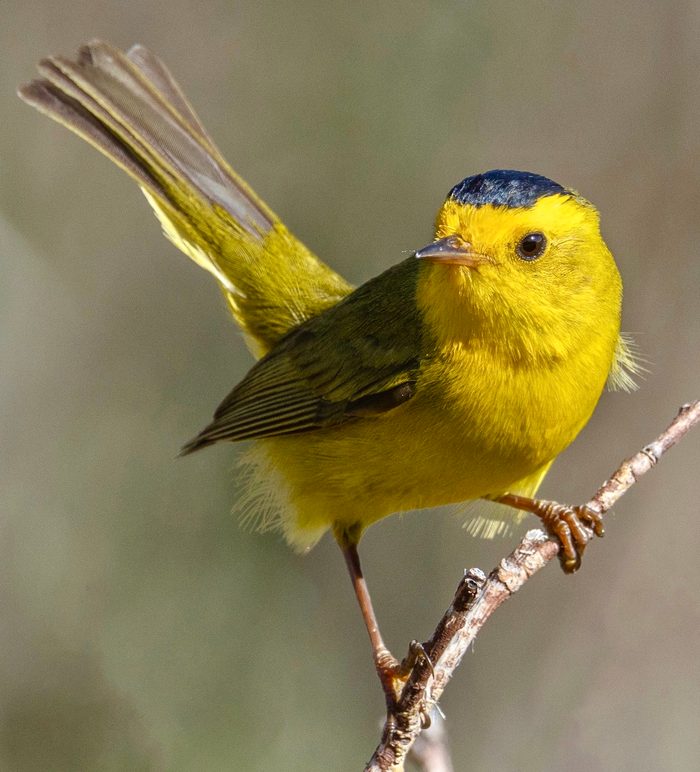
Look for them in shrubby areas near streams in mid- to late spring. Typically, the Wilson’s is one of the last migrating warblers to arrive. As a definite perk for birders, the Wilson’s tends to be found closer to the ground than other warblers, who can often require much uncomfortable neck-craning to spot.
These amazing pictures of warblers will make you want to go birding.
Diet: What Does a Wilson’s Warbler Eat?
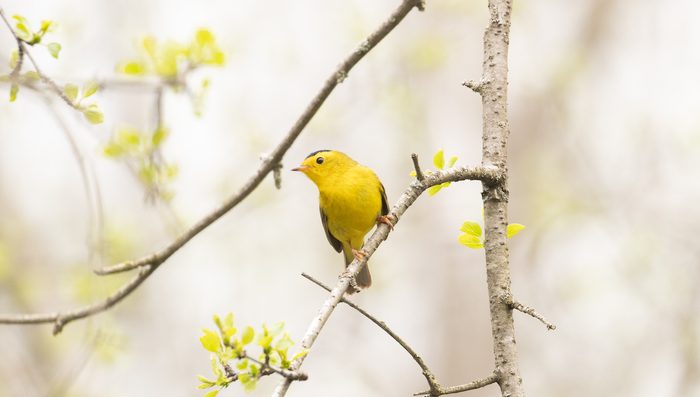
As a warbler, it’s unsurprising to hear the Wilson’s dines on insects. Snatching spiders, caterpillars, and beetles in brush, they’re also talented fliers and will grab flies, bees, and other insects in the air.
Learn more about what warblers eat and how to attract them.
Nesting Habits
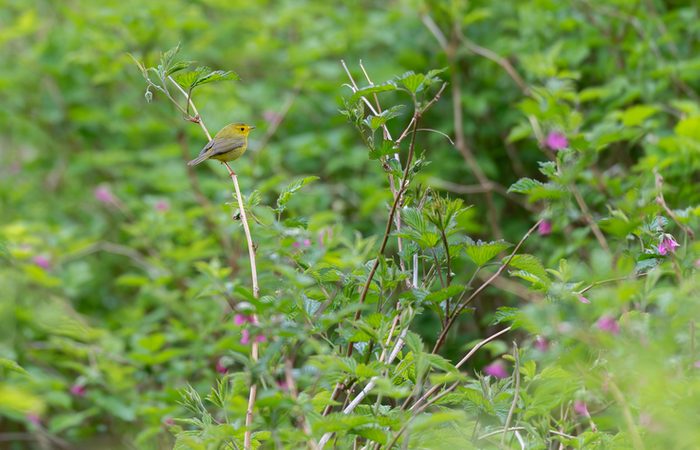
Female Wilson’s warblers are ground-nesting birds. They’ll construct their nest in a concealed location and might even wedge it between branches in shrubs to keep it in place. Raising up to two broods per season consisting of two to seven chicks, these baby birds will remain in the nest for a week and a half before leaving the nest.
Learn how to identify a yellow warbler.
Wilson’s Warbler Song
This species has a short, simple song with repeating notes, pausing before singing again. Unlike most other warblers, females also occasionally sing.
Bird songs courtesy of the Cornell Lab of Ornithology
About the Expert
Lifelong birder and ornithologist Dr. Kevin McGowan is a senior course developer for the Cornell Lab of Ornithology’s Bird Academy. He earned a Ph.D in biology at the University of South Florida.
Sources
- All About Birds – Wilson’s warbler
- Kaufman Field Guide to Birds of North America
- Merriam-Webster online dictionary
Why Trust Us
For nearly 30 years, Birds & Blooms, a Trusted Media Brand, has been inspiring readers to have a lifelong love of birding, gardening and nature. We are the #1 bird and garden magazine in North America and a trusted online resource for over 15 million outdoor enthusiasts annually. Our library of thousands of informative articles and how-tos has been written by trusted journalists and fact-checked by bird and garden experts for accuracy. In addition to our staff of experienced gardeners and bird-watchers, we hire individuals who have years of education and hands-on experience with birding, bird feeding, gardening, butterflies, bugs and more. Learn more about Birds & Blooms, our field editor program, and our submission guidelines.
On This Page
Native Bees: What Gardeners Need to Know
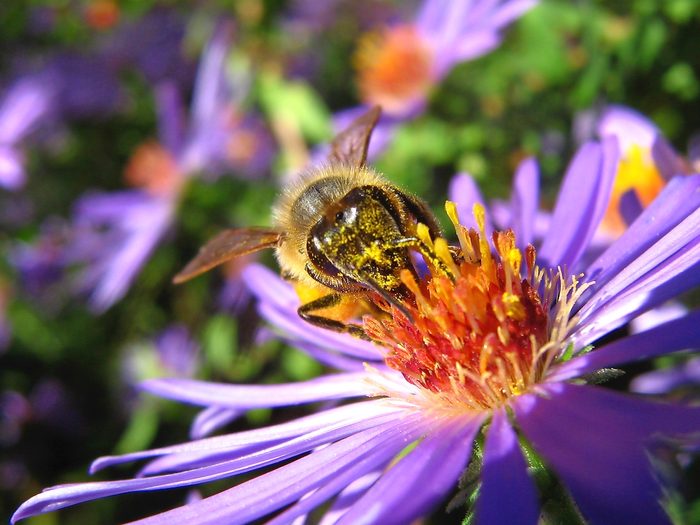
In the world of bees, honey bees get a lot of attention and right now, massive numbers of honey bees are disappearing. This phenomenon, known as colony collapse disorder, threatens both beekeeping operations and the pollination of crops and natural landscapes.
Although colony collapse doesn’t impact native bees (honey bees originated in Europe), the possible causes behind colony collapse, like pesticide use, habitat loss and disease, easily could. Native bee populations are seeing declines, though not as widely documented as those of honeybees, says Mace Vaughan, co-director of the Pollinator Conservation Program of the Xerces Society for Invertebrate Conservation.
Among native bumblebees, 30 percent of species have experienced significant drop-offs that could lead to extinction. Concern about colony collapse has brought attention to the critical pollination role of all bees and their plight, and also spotlighted what people can do to help bees, says David Mizejewski, a naturalist with the National Wildlife Federation.
To create a yard that’s safe and attractive to native bees, it’s important to understand these pollinators first.
Native Bees Hide in Plain Sight
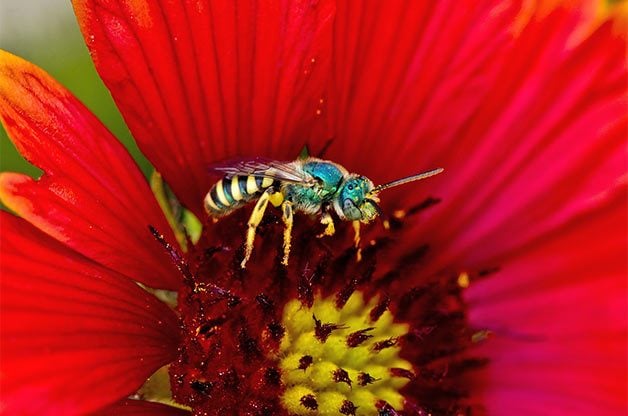
Native bees can look different from how we often visualize these flying insects. “Most of the things we learn about bees as kids aren’t true about native bees,” David says.
They exist in an array of colors, including metallic green, brown, black and gray, as well as the stereotypical yellow-and-black stripes. Native bees can be quite small and are often mistaken for flies.
It’s also useful to note that native bees tend to be docile. “Many can’t sting humans,” says Heather Holm, the author of Pollinators of Native Plants. “Their stingers can’t even pierce our skin.”
Learn how to help bees and pollinators in 10 easy ways.
Native Bees Nest in the Ground
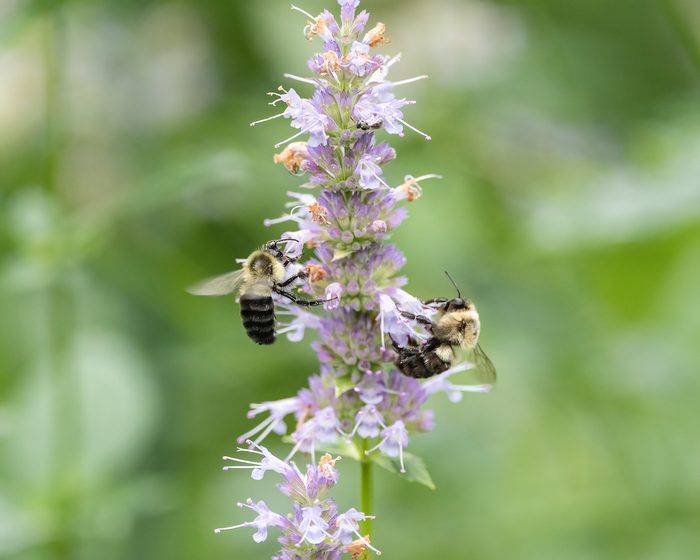
Most solitary bee species nest in the ground; the rest use tunnels like hollow stems or burrow into dead wood. Inside these nesting sites, the female bee creates a pollen loaf, lays a single egg on it, then starts a new nesting site and repeats the process.
To create a safe habitat for this type of nesting, it’s essential to have areas of undisturbed and loose ground. Bees tend to select south-facing slopes with well-drained soil, which can be warmer and drier, and make for good nesting sites. Heather suggests forgoing mulch in spots where you’d like to see bees nest. “Many of the bees are small and can’t get through a layer of mulch,” she says.
When cutting back your plants in fall, leave behind foot-long lengths of pithy or hollow stems for the tunnel nesters; cavity-nesting bees will also use those stems the next year. You can also create natural bee houses by bundling together hollow stems and hanging them in the yard. Fallen wood, brush piles or old fence posts also provide good nesting sites.
Learn what to do if you see a bald-faced hornet nest.
Native Bees Are Really Busy— Help Them Out
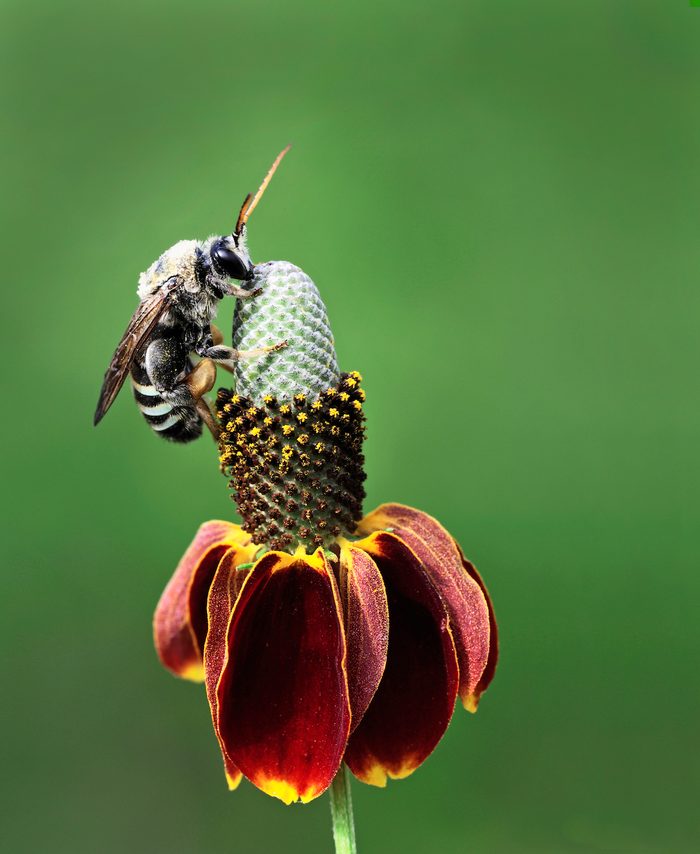
Most female native bees are active as adults for two to six weeks. During that time, they are collecting pollen to create as many loaves and lay as many eggs as possible. To make foraging for pollen less arduous, provide a diverse selection of flowers from spring to fall and plant them in groups.
New generations and different species of bees are emerging throughout the growing season and it’s essential that they have enough flowers for pollen collection. Heather advises gardeners identify flowering gaps during the growing season and add plants to the yard accordingly. “Bees need that continuous succession of plants flowering,” she says. If possible, plant flowers in masses about three feet across.
“As bees are flying across a landscape, a cluster of flowers has a billboard effect,” Mace says. “It’s also efficient, allowing bees to visit many flowers rapidly.”
Meet 7 beneficial garden bees you want in your backyard.
Native Flowers Are Best for Native Bees
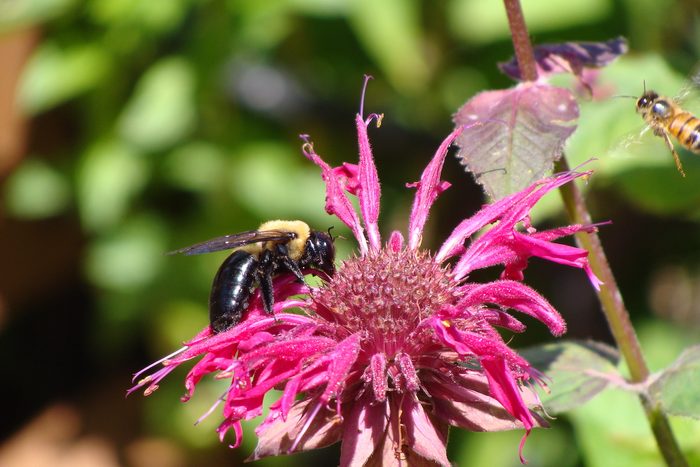
The relationship between bees and flowers is symbiotic—bees need the flowers for nectar and pollen, and flowers need the bees for pollination. A flower might be specialized to allow pollination only from certain species of bees, or its structure might help assure proper pollination, Heather says.
For instance: If nectar is deep in a flower, a bee will have to push its way into the flower to get at it. For a large, strong bee, like a bumblebee, this is an easy task and the flower deposits pollen on the bee in the process. A smaller bee might not be able to get to the nectar and will seek another flower.
Bring in a hybridized flower, like a cultivar that will display double blooms or a different color, and who knows what effect that change might have on its pollen or nectar. “When we select cultivars of native plants, we don’t know how that is affecting other attributes of the flowers that are important to pollinators and wildlife,” David says.
In the name of attracting bees, it’s best to choose heirloom plants or those bred as little as possible. For ideas, stroll through your local garden center and see what plants are covered with bees, Mace says. Some of the flowers he recommends are:
But depending on the conditions in your yard, there are hundreds of plants that will work. (Find plant lists for different regions at xerces.org.) “The point is that everybody can do something for the bees and everybody can have something pretty,” Mace says. “Plant the right flowers and avoid pesticides. Do that and you’ll be rewarded.”
Discover a new appreciation for wasps: pollinators and pest control.
Bee Garden Basics
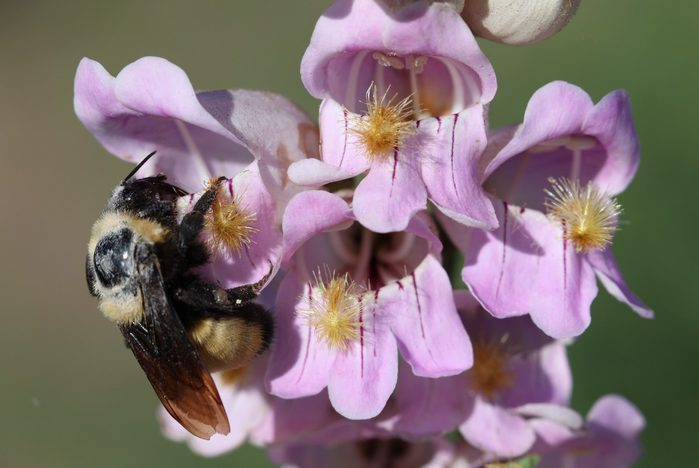
When gardening for bees, here are a few general rules of thumb:
- Choose a range of flower shapes and colors to attract the most bee species. Bumblebees can easily collect pollen from complex flowers, while smaller bees appreciate simple flower shapes and a flat place to land.
- Plant season-long blooms to support bees from early spring until fall.
- Provide areas of undisturbed ground or vegetation for nesting sites.
- Bees and flowers have evolved in tandem, so choose non-hybrid natives.
- Plant in masses for efficient pollen collection. Sunny areas are most attractive.
- Avoid pesticide use. Even some organic mixtures can harm insects.
- Provide a muddy area or shallow trough for water.
About the Experts
Mace Vaughan has lead the the Pollinator Conservation Program of the Xerces Society since 2003. He earned degrees in entomology, teaching, and natural resources management from Cornell University, and has written many articles and publications on native insect conservation.
David Mizejewski is a naturalist and TV host with the National Wildlife Federation. He earned degree in human and natural ecology from Emory University and is an expert on wildlife conservation.
Heather Holm is an award-winning author of Pollinators of Native Plants; Wasps, a Guide for Eastern North America; and Common Native Bees of the Eastern United States. She has been featured in the New York Times and is dedicated to pollinator conservation.
Why Trust Us
For nearly 30 years, Birds & Blooms, a Trusted Media Brand, has been inspiring readers to have a lifelong love of birding, gardening and nature. We are the #1 bird and garden magazine in North America and a trusted online resource for over 15 million outdoor enthusiasts annually. Our library of thousands of informative articles and how-tos has been written by trusted journalists and fact-checked by bird and garden experts for accuracy. In addition to our staff of experienced gardeners and bird-watchers, we hire individuals who have years of education and hands-on experience with birding, bird feeding, gardening, butterflies, bugs and more. Learn more about Birds & Blooms, our field editor program, and our submission guidelines.
On This Page
What Do Snails Eat?
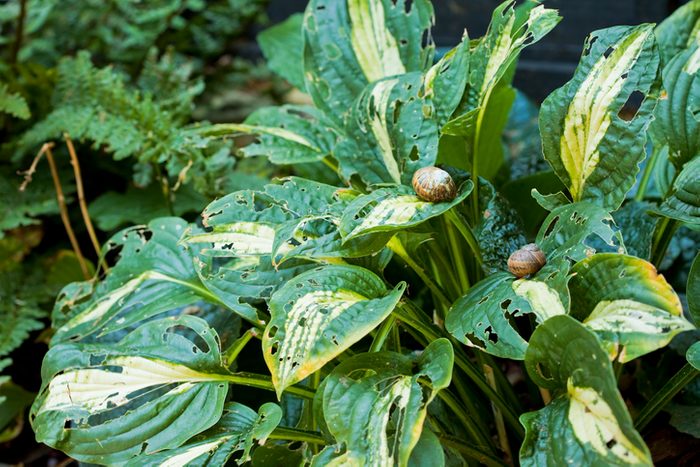
Snails aren’t too picky when it comes to their meals. They’ll eat pretty much whatever they can find, from plant matter to animal waste (and, in some cases, even other snails).
Like learning about snail facts? You’ll love learning facts about fireflies, too.
Do Snails Have Teeth?
Snails do have teeth—a whole lot of them. Through a structure called a “radula” in their mouths, snails pry off pieces of what they’re eating and further break it down. The radula features up to 12,000 teeth, which is… a whole lot. Not keen on those teeth being used on your garden? Here’s how to get rid of slugs and snails.
How Long Do Snails Sleep?
Snails do sleep, but they do so quite a bit differently from humans. A typical snail sleep cycle lasts a few days (usually 2 to 4). After that, a snail can stay awake for longer than a full day. Snails are nocturnal, meaning they typically come out at night, just like moths. In some instances, snails have slept for years!
Is a Snail an Insect?
It might be tempting to categorize a snail as an insect, what with the antennae and all. But snails aren’t part of the same family as the bugs in your yard. Instead, they’re mollusks, a group that also includes slugs, octopi, and squid.
Are Snails Born With Their Shells?
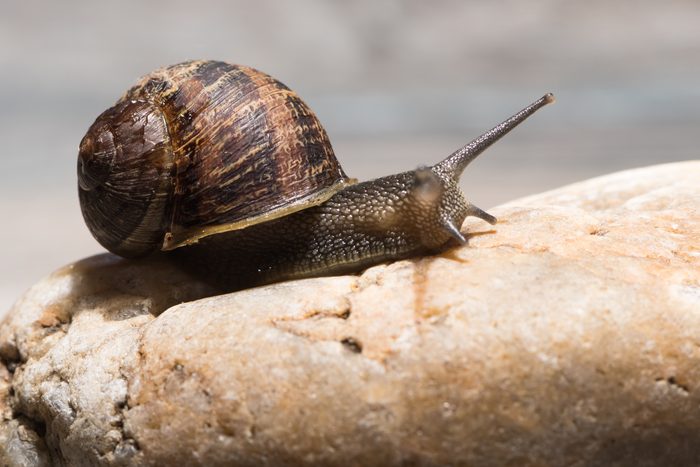
One of the greatest snail mysteries is its shell. Where does it come from? You might be surprised to learn that snails never “switch” shells, and they rarely (if ever) leave them. Snails are born with their shells. As the snail grows, the shell grows too. The snail shell is an integral part of the creature and essential for its survival. Without it, the snail risks drying out. Snails can even repair damage to them!
Difference Between Slugs vs Snails
While they’re part of the same family and are both part of the gastropod class, slugs and snails are not technically the same. Beyond the obvious (one has a shell, one doesn’t), slugs can be found in different habitats as a result of their differently shaped bodies.
How Fast Do Snails Move?
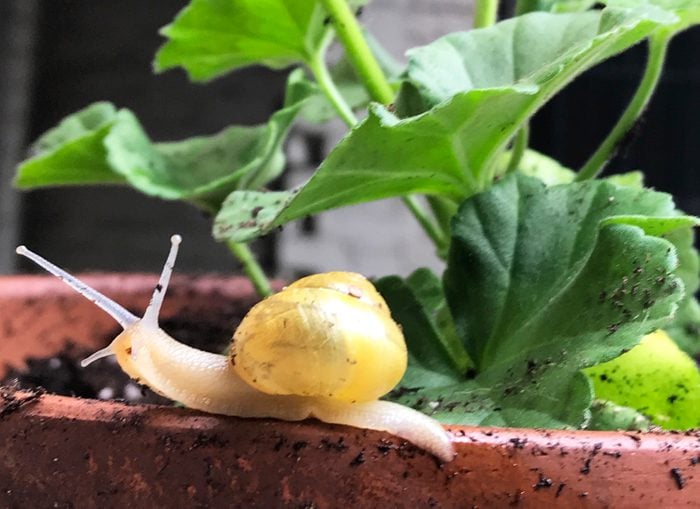
If you wanted to race a snail, you wouldn’t have a hard time winning. Not known for their speediness, snails move at a pace of just over three feet, or one meter, in an hour.
What Does “Snail Mail” Mean?
It’s not abundantly clear who first said the term “snail mail,” but we do know why it joined the popular lexicon. As email rose as a popular form of communication, a term was needed to distinguish electronic mail from physical mail, and thus, “snail mail” was coined.
After you’re done looking at snail facts, check out extraordinary facts about bird eggs.
Sources
- Natural History Museum of Los Angeles County
- BBC Science Focus
- University of Florida Pest Control Guides
- Smithsonian Magazine
- Merriam-Webster Dictionary
- Britannica
- Iowa Department of Natural Resources
Why Trust Us
For nearly 30 years, Birds & Blooms, a Trusted Media Brand, has been inspiring readers to have a lifelong love of birding, gardening and nature. We are the #1 bird and garden magazine in North America and a trusted online resource for over 15 million outdoor enthusiasts annually. Our library of thousands of informative articles and how-tos has been written by trusted journalists and fact-checked by bird and garden experts for accuracy. In addition to our staff of experienced gardeners and bird-watchers, we hire individuals who have years of education and hands-on experience with birding, bird feeding, gardening, butterflies, bugs and more. Learn more about Birds & Blooms, our field editor program, and our submission guidelines.
On This Page
Cardinal Flower Pollinator Benefits
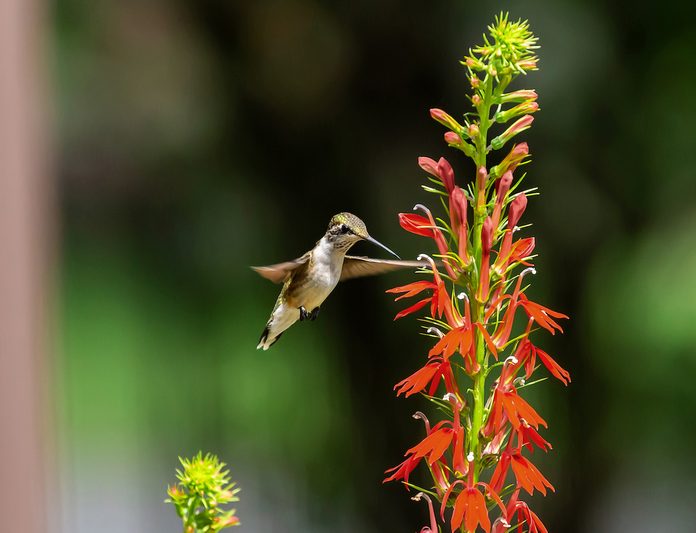
Looking for an interesting North American native plant with striking color that attracts butterflies and hummingbirds? Cardinal flower (Lobelia cardinalis) might be the answer, though it doesn’t work for every location. If you can provide good wet soil and a little afternoon shade, though, the spikes of cardinal flower will reward you with visits from plenty of pollinators.
Eye-catching stalks of vibrant scarlet, white or rose flowers pop in a summer garden from July to September. Deer and rabbits usually avoid the plant. It adds height to edges and thrives in moist, challenging growing conditions like rain gardens, along ponds and in wet meadows.
Check out the best red flowers that attract hummingbirds.
Cardinal Flower Care and Growing Tips
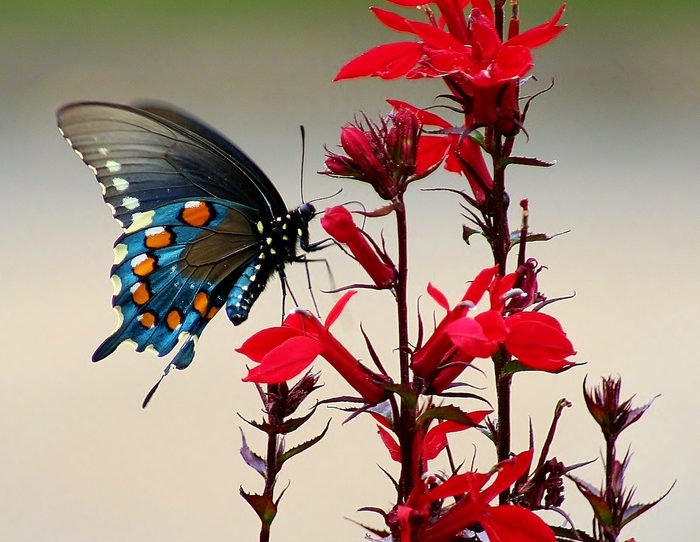
- Scientific name: Lobelia cardinalis
- Growing zones: 3 to 9
- Attracts: Butterflies, hummingbirds, bees
- Light needs: Prefers partial shade; place it in a spot with morning sun and moist soil
- Size: Shoots 2 to 4 feet high, spreads up to 2 feet wide
- Grown for: Nectar-packed, showy blooms hummingbirds love
- Foliage: Tall stalks with long, thin, dark-green leaves
- Cultivars to try: Pink Flamingo is a dazzling pink flowering beauty; sun-loving Queen Victoria adds drama with scarlet blooms and dark foliage
Cardinal flower is native to the eastern United States, where it grows in wet woodlands. The flower spikes can reach 4 feet tall. It will re-bloom throughout the summer, especially when spent spikes are trimmed back to encourage new growth. These vibrant blooms add eye-popping color to your shady areas.
The plant does need consistently moist or wet soil to thrive, so if you have a soggy spot in the yard, or are looking to grow something along the edge of a backyard pond, this is a great solution. Surround it with mulch to retain moisture during summer and protect its root system during cold northern winters.
Did you know: This plant is named for the red robes worn by Roman Catholic cardinals, not the popular redbirds in your backyard.
Is Cardinal Flower a Perennial?
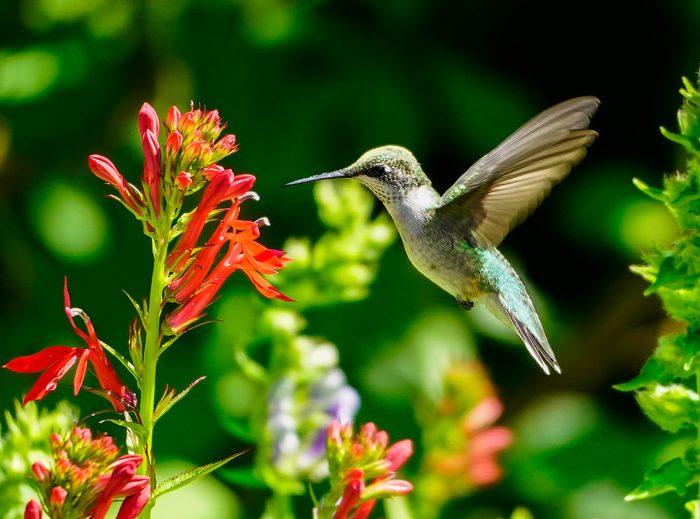
Cardinal flower is a short-lived perennial in the bellflower family. It spreads by basal rosettes at the base of the plant, which can be divided every few years, and also by seed.
Psst—these are the best perennials to grow for hummingbirds.
Great Blue Lobelia
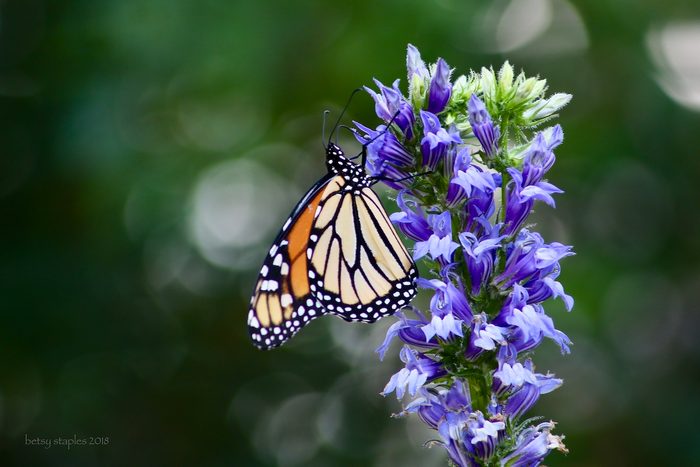
Great blue lobelia is cardinal flower’s blue counterpart (Lobelia siphilitica, Zones 4 to 9). The two are very eye-catching when planted together. Great blue lobelia prefers a bit more sun but still requires moist soil. If you’re looking to attract hummingbirds, though, red cardinal flower is your best bet.
Sources
- National Gardening Association — Pink Flamingo
- National Gardening Association — Queen Victoria
- American Meadows – Cardinal flower
- North Carolina Cooperative Extension — Great blue lobelia
- University of Wisconsin-Madison Division of Extension — Cardinal Flower, Lobelia cardinalis
Why Trust Us
For nearly 30 years, Birds & Blooms, a Trusted Media Brand, has been inspiring readers to have a lifelong love of birding, gardening and nature. We are the #1 bird and garden magazine in North America and a trusted online resource for over 15 million outdoor enthusiasts annually. Our library of thousands of informative articles and how-tos has been written by trusted journalists and fact-checked by bird and garden experts for accuracy. In addition to our staff of experienced gardeners and bird-watchers, we hire individuals who have years of education and hands-on experience with birding, bird feeding, gardening, butterflies, bugs and more. Learn more about Birds & Blooms, our field editor program, and our submission guidelines.
On This Page
Liatris Care and Growing Tips
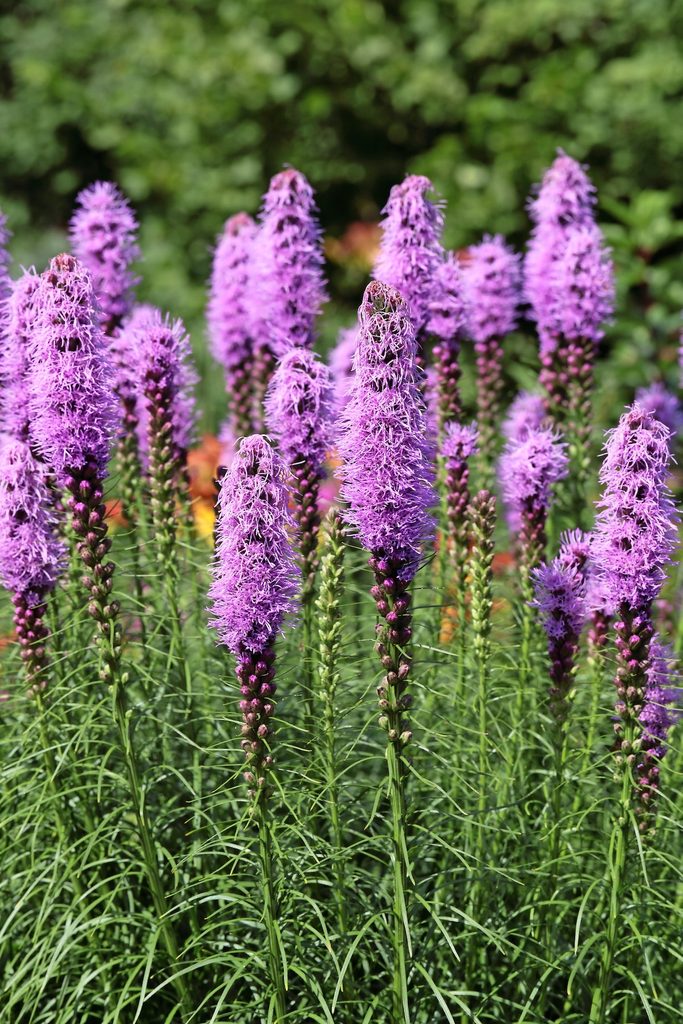
- Common names: blazing star, gayfeather
- Scientific name: Liatris spp.
- Zones 3 to 8
- Attracts: birds, butterflies, bees
- Light needs: Full sun
- Size: 2 to 5 feet tall
- Grown for: Butterfly gardens, borders, cottage gardens and meadows
- Foliage: Lance-shaped leaves
- Cultivars to try: Alba tends to grow a little shorter than other liatris and has white flowers. For a smaller plant with purple blooms, grow Kobold Original.
Blazing star (Liatris spp.) is part of the Aster family (Asteraceae). The plant is a beacon to butterflies and hummingbirds. Purple flowers bloom in late summer or early fall, depending on the species, and last for a month or two. Liatris can be planted in poor soil, but needs plenty of sun. Many species are native to the eastern U.S.
Liatris Species to Grow
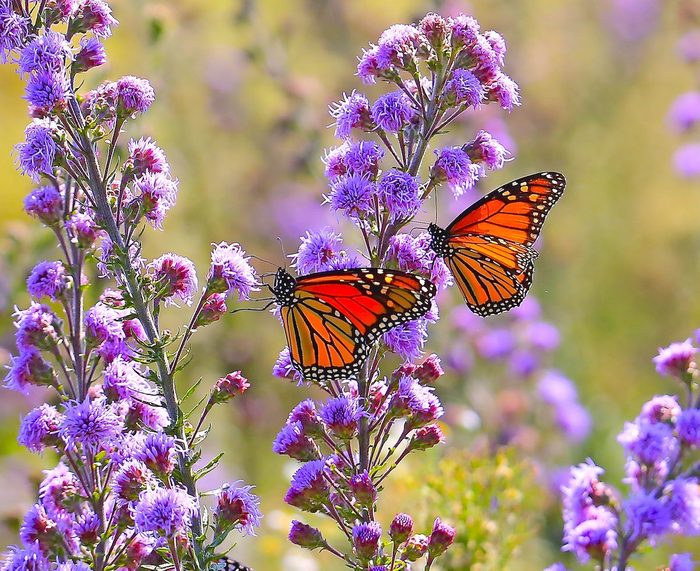
The 50 or species of this genus are all native to North America. The most common species you’ll find in cultivation is Liatris spicata, sometimes known as dense blazing star or gayfeather. There are multiple cultivars available, including some with pink and white flowers. Dwarf varieties like Kobold are good for smaller gardens, measuring around 2 feet tall.
L. spicata is suited to zones 3 to 8, and requires regular water to flower best. It can be difficult to grow in the Deep South due to its intolerance of high heat and humidity. Fortunately, there are other blazing star species available for a wide range of growing conditions. Your best bet is to seek out the species that are native to your area.
Try prairie blazing star (L. pycnostachya) for radiant rosy purple flowers in zones 3 to 9. It will reseed readily. Tall and spindly meadow blazing star (L. ligulistylis) is a monarch butterfly favorite with showy, long-lasting flowers that appear in late summer.
When to Plant Liatris
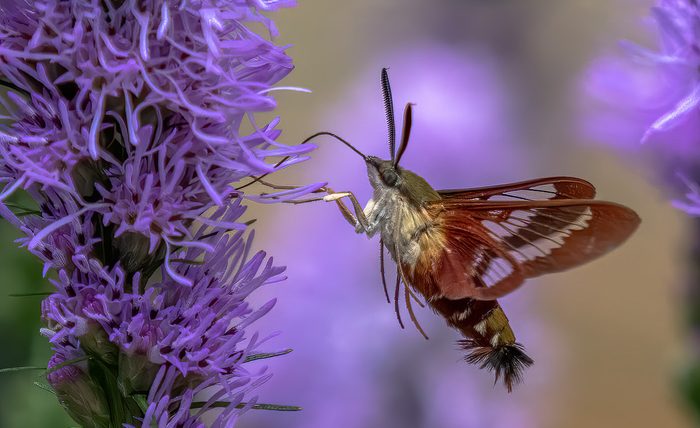
Liatris is somewhat difficult to grow from seed. You can buy potted plants or corms (similar to bulbs) and plant them in the spring for blooms in late summer and fall.
Birds & Blooms reader Barbara Giese of Manitowoc, Wisconsin, asks, “Is September too late in the year to plant liatris corms?”
Gardening expert Melinda Myers says, “It’s best to plant liatris corms in spring or early summer. You could either store them for winter or try planting them this fall with other spring-flowering bulbs. If you decide to plant them in fall, wait for the soil to cool so the corms do not sprout this year.”
Liatris Wildlife Benefits
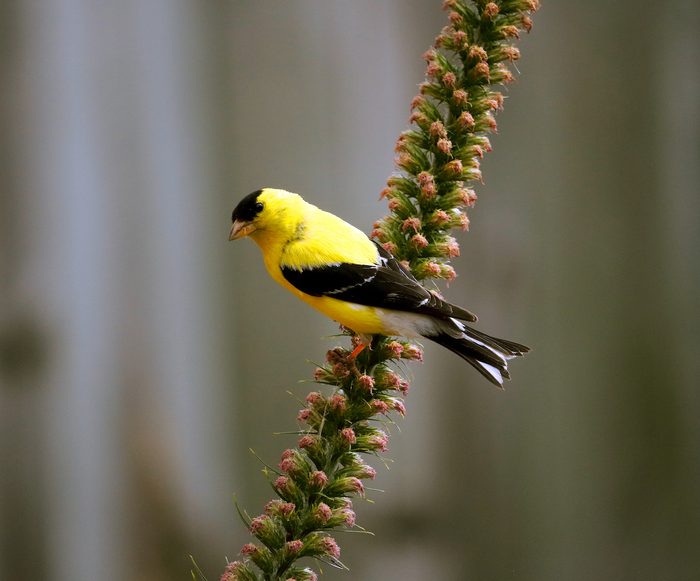
The beautiful purple spikes of blazing star add color and interest to any butterfly garden, with stacks of small fuzzy flowers that are full of nectar. This bloom draws butterflies and other pollinators in droves. It’s a magnet for monarchs and tiger swallowtails, and also attractive to silver-spotted skippers, red admirals, painted ladies and sulphurs. Hummingbirds are known to swing by for a drink of nectar, too.
After the flowers fade and dry, liatris still attracts wildlife and provides winter interest. Songbirds hover around the fluffy seed heads, picking away at the seeds.
Check out the top 10 purple flowers that attract hummingbirds.
Where to Plant Liatris
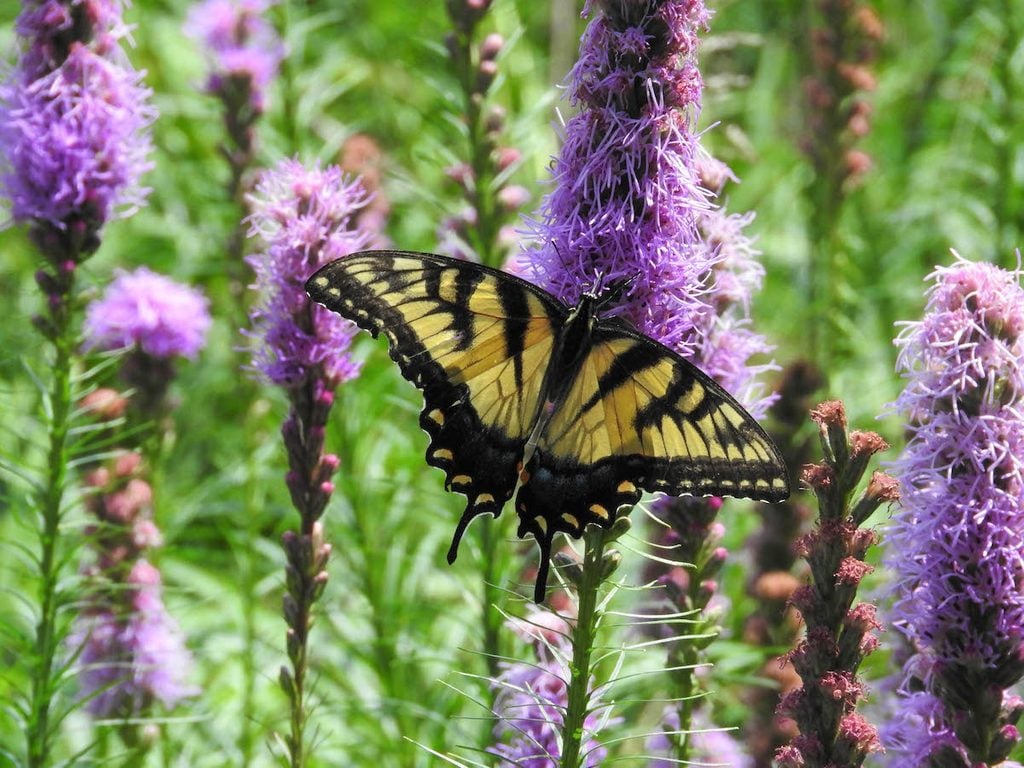
Blazing star is a natural choice for a butterfly garden. Plant tall varieties along the back of beds or in the center for interest. Plan to provide some support in more formal garden settings. The stems have a tendency to fall over, especially after heavy rains. Most gardeners report that liatris is generally deer-resistant. Dwarf varieties make excellent cutting garden flowers.
Next, check out the best host plants for butterflies.
Sources
- Missouri Botanical Garden
- University of Wisconsin-Madison Division of Extension, Liatris
- Monrovia
- North Carolina Cooperative Extension
- The Morton Arboretum
About the Expert
Melinda Myers is the official gardening expert for Birds & Blooms. She is a TV/radio host, author and columnist who has written more than 20 gardening books. Melinda earned a master’s degree in horticulture from the University of Wisconsin-Madison.
Why Trust Us
For nearly 30 years, Birds & Blooms, a Trusted Media Brand, has been inspiring readers to have a lifelong love of birding, gardening and nature. We are the #1 bird and garden magazine in North America and a trusted online resource for over 15 million outdoor enthusiasts annually. Our library of thousands of informative articles and how-tos has been written by trusted journalists and fact-checked by bird and garden experts for accuracy. In addition to our staff of experienced gardeners and bird-watchers, we hire individuals who have years of education and hands-on experience with birding, bird feeding, gardening, butterflies, bugs and more. Learn more about Birds & Blooms, our field editor program, and our submission guidelines.
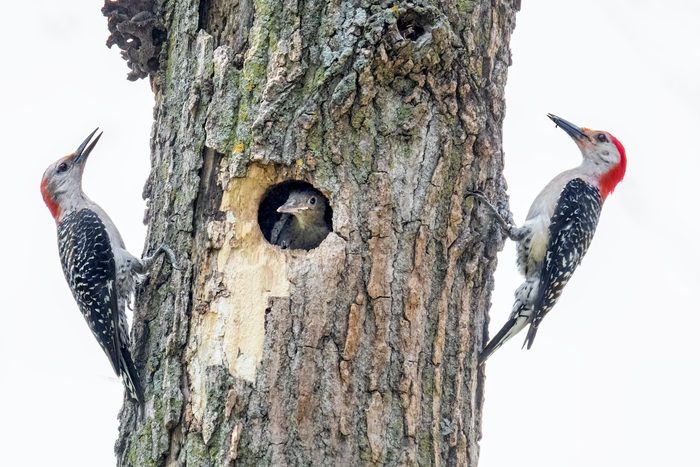
For parent birds, raising a nest full of babies can be a risky project. With predators around every corner, many parents hide their nests among dense foliage or in tall grass for protection. Another approach is to put it inside a tree. This cavity nesting strategy is practiced by all kinds of birds, including some that you can attract to your backyard.
Learn about 9 different types of bird nests and how to spot them.
On This Page
New Cavity Nest Builders
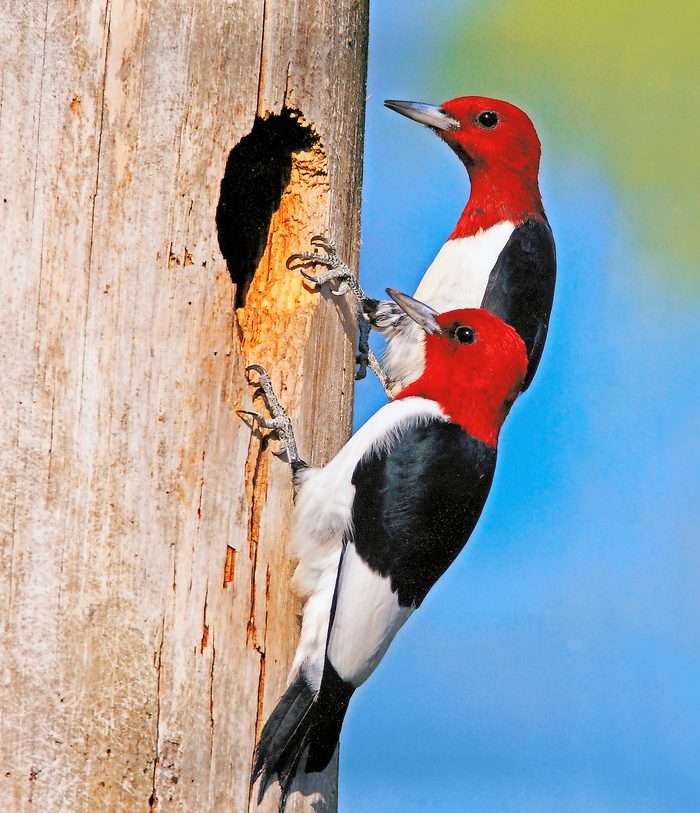
Left alone, a mature tree may develop natural cavities in spots where branches have fallen off or large limbs have decayed from within. But some birds don’t wait around for these cavities to develop—they make their own. Members of the woodpecker family are expert homebuilders. They usually excavate their own nest holes, choosing spots in dead trees or limbs.
They’re quite industrious about it, too. Typically, a pair of woodpeckers will dig a new nest hole for each new brood that they raise. In fall, they also dig holes to roost in during winter. Because they tend to keep excavating new holes instead of reusing old ones, they leave behind ready-made nest sites for many other birds.
Learn all about woodpecker nests and eggs.
Fixer-Upper Cavity Nesters
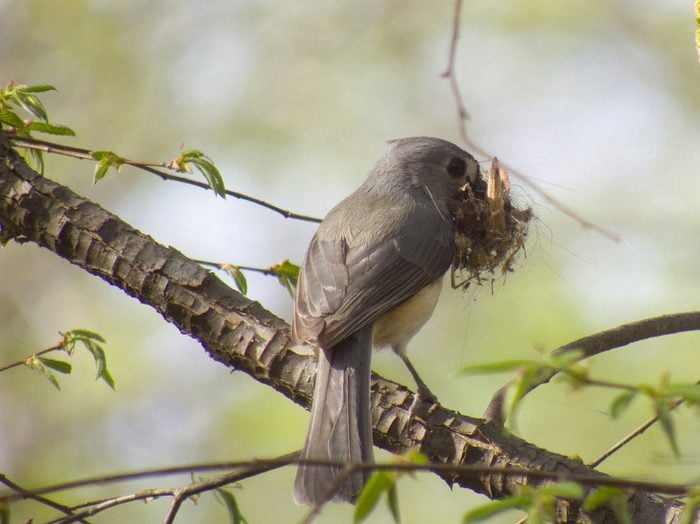
Most birds don’t have the chisel-shaped bills of woodpeckers, so they aren’t so well-equipped for excavating in dead wood. But some cavity nesters are willing to enlarge or modify existing small holes, and sometimes create their own.
Chickadees, with their tiny bills, don’t look as if they could create their own nest cavities, but they often do, enlarging a small knothole or digging a complete hole in soft, decaying wood. Nuthatches may modify existing holes or dig new ones. The oak titmouse on the West Coast will alter holes to suit its needs, but its eastern cousin, the tufted titmouse, seems to simply use holes as it finds them.
Psst—here’s everything you need to know about hummingbird nests.
Cavity Nesters That Use Birdhouses
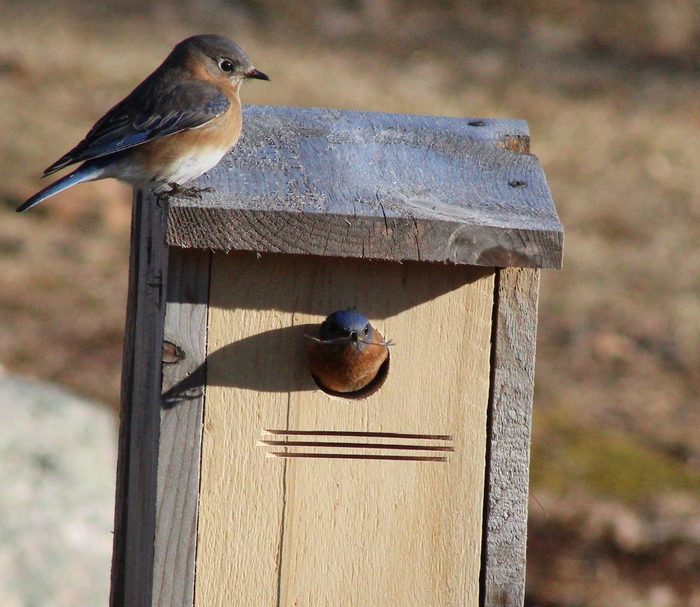
A standard birdhouse, or nest box, simply is an artificial version of a natural tree cavity. Several popular birds have adapted to nest boxes, giving backyard birders abundant opportunities for up-close views. Bluebirds are found all across the continent, and all three species—eastern, western and mountain—raise their young either in natural cavities or in nest boxes. The bluebird’s popularity has been a bonanza for the tree swallow, another cavity nester, which uses holes of the same size.
Learn how to make a DIY bluebird house.
The purple martin is another classic birdhouse species in eastern North America. Practically all martins east of the Rockies now nest in multiroomed martin houses, sometimes with dozens of pairs in the same structure. In the West, some martins still nest in the traditional way, in cavities in dead trees—or, in the Arizona desert, in holes in giant cactus.
Wrens: The Flexible Cavity Nesting Birds
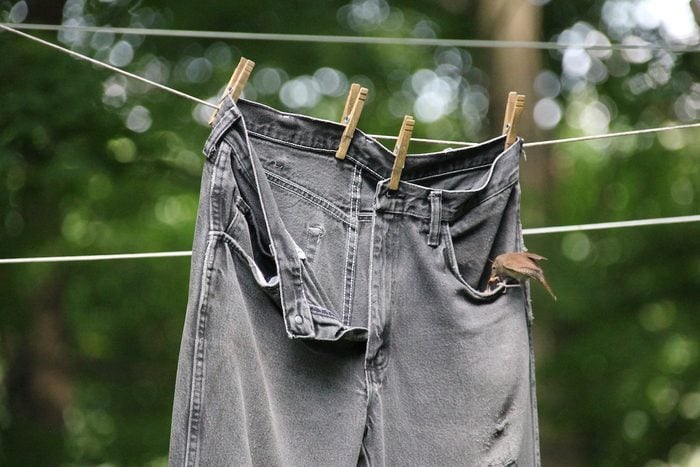
Wrens are mostly shades of brown and gray, but they make up for their lack of bright colors with high-energy personalities and musical songs. Five species—about half our wrens—are cavity nesters. The house wren is widespread from coast to coast, while the Bewick’s wren lives mainly in the West, and the Carolina wren is most common in the Southeast. The tiny winter wren nests in the Northwoods, while its close relative, the Pacific wren, resides in the Far West.
These birds loosely define a “cavity” for nesting. They will nest in standard tree holes or nest boxes, but they also use crevices in buildings, hollows among the roots of fallen trees, old flowerpots in sheds—just about any enclosed space. House wrens have even been found building nests in the pockets of trousers hanging on clotheslines!
Can you move a bird nest near your home?
Surprising Cavity Nesting Birds
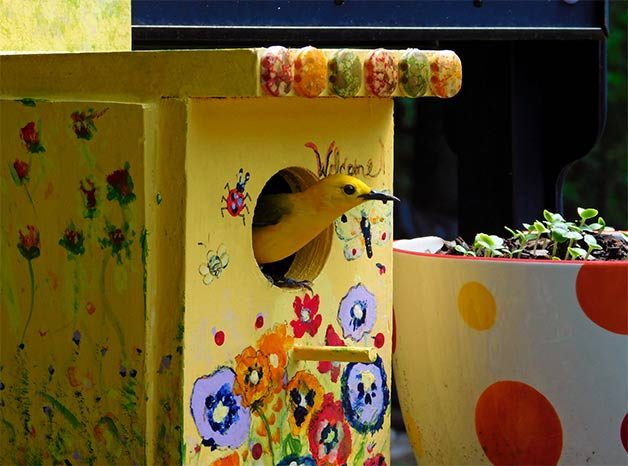
Several other types of birds are also among the cavity nesting crew. Various kinds of owls nest in cavities, including little screech-owls, which may lurk unnoticed in holes even in suburban backyards. The American kestrel, a colorful little falcon, uses tree holes or nest boxes in open country. Flashy wood ducks adopt tree hollows or nest boxes close to the water; hooded mergansers, common goldeneyes and buffleheads are among the other cavity-nesting waterfowl.
Those are all fairly large birds, but our last two examples are tiny. Of the 55 species of warblers in North America, only two nest in cavities: Lucy’s warbler, a pale gray bird of southwestern deserts, and the prothonotary warbler, a brilliant golden sprite of southeastern swamps. They remind us that nature is full of surprises. They also remind us that, regardless of what your dentist might say, cavities can be good things!
Learn how to attract owls to nest in your backyard.
Why Trust Us
For nearly 30 years, Birds & Blooms, a Trusted Media Brand, has been inspiring readers to have a lifelong love of birding, gardening and nature. We are the #1 bird and garden magazine in North America and a trusted online resource for over 15 million outdoor enthusiasts annually. Our library of thousands of informative articles and how-tos has been written by trusted journalists and fact-checked by bird and garden experts for accuracy. In addition to our staff of experienced gardeners and bird-watchers, we hire individuals who have years of education and hands-on experience with birding, bird feeding, gardening, butterflies, bugs and more. Learn more about Birds & Blooms, our field editor program, and our submission guidelines.